Lecture 1 - Intro to Microbiology, History - Part 1
1/95
There's no tags or description
Looks like no tags are added yet.
Name | Mastery | Learn | Test | Matching | Spaced |
|---|
No study sessions yet.
96 Terms
Microbiology
The study of organisms too small to be seen with the unaided eye
“microscopes = new eyes"
Why should we study Microbiology?
Ubiquitous = “microbes are everywhere”
Beneficial effects
Harmful effects
Ubiquitous
THEY ARE EVERYWHERE
“microbes are adapted for each type of environment, not just warm and moist”
Studying Microbiology: Beneficial Effects
Maintain ecological balance
Human digestion and vitamin synthesis
Commercial applications
Beneficial Effects: Maintain Ecological Balance
Basis of the food chain
“very small!! larger organisms eat them, then larger ones eat those organisms”
Photosynthesis - provide oxygen
“Take CO2 from environment and turn into sugars”
“70-80% of O2 in atmosphere from microbes”
-”usually marine algae”
Decomposers - recycle nutrients
“help breakdown organic material”
Beneficial Effects: Human Digestion and Vitamin Synthesis
“colon”
“B12, biotin, folic acid, thymine, etc.”
Beneficial Effects: Commercial Applications
Food and beverage
Ex: pickles, sauerkraut, soy sauce, yogurt, bread, alcohol, cheese
Antibiotics
Vaccines
Genetic Engineering
“manipulate microorganisms using their genetic info”
“subclone genes, splice things, cut DNA b/c of enzymes, etc.”
Studying Microbiology: Harmful Effects
Pathogenic: disease causing
Food spoilage
“Could lead to digestive diseases as well”
Breakdown/damage useful material
Nomenclature
Naming organisms
Established by Carolus Linnaeus in 1735
Binomial: two names
“Latin naming system”
Genus: CAPITALIZED, underlined (“when handwriting”) or italics (typed)
Scientific epithet (species): lower cased, underlined (handwritten) or italics (typed)
Names can describe organism, habitat, or identify researcher, etc…
Types of Microorganisms
Prokaryotes
Eukaryotes
Acellular forms
“different organisms that lack a cell”
Types of Prokaryotes
Bacteria
“main focus in lab, we manipulate and grow”
Archaea
Structure of Bacteria
Unicellular
“single-celled organisms”
Prokaryote: lack of true nucleus or membrane bound organelles
Shape:
Cocci (spherical)
Bacillus (rod)
Spiral (corkscrew “or slinky”)
Cell wall: peptidoglycan
“part protein, part sugar”
Additional structures: some have flagella (motility)
Reproduction of Bacteria
Binary fission: dividing into 2 equal cells
Nutrition of Bacteria
Heterotrophic: requires organic carbon source (most)
Saprophytic: uses dead organic matter nutrients
Autotrophic: uses carbon dioxide (“inorganic”) as main carbon source (some)
Size of Bacteria
micrometers
= “1/1000th of mm”
Examples of Bacteria
MRSA
Helicobacter pylori
Bacillus anthracis
Clostridium botulinum
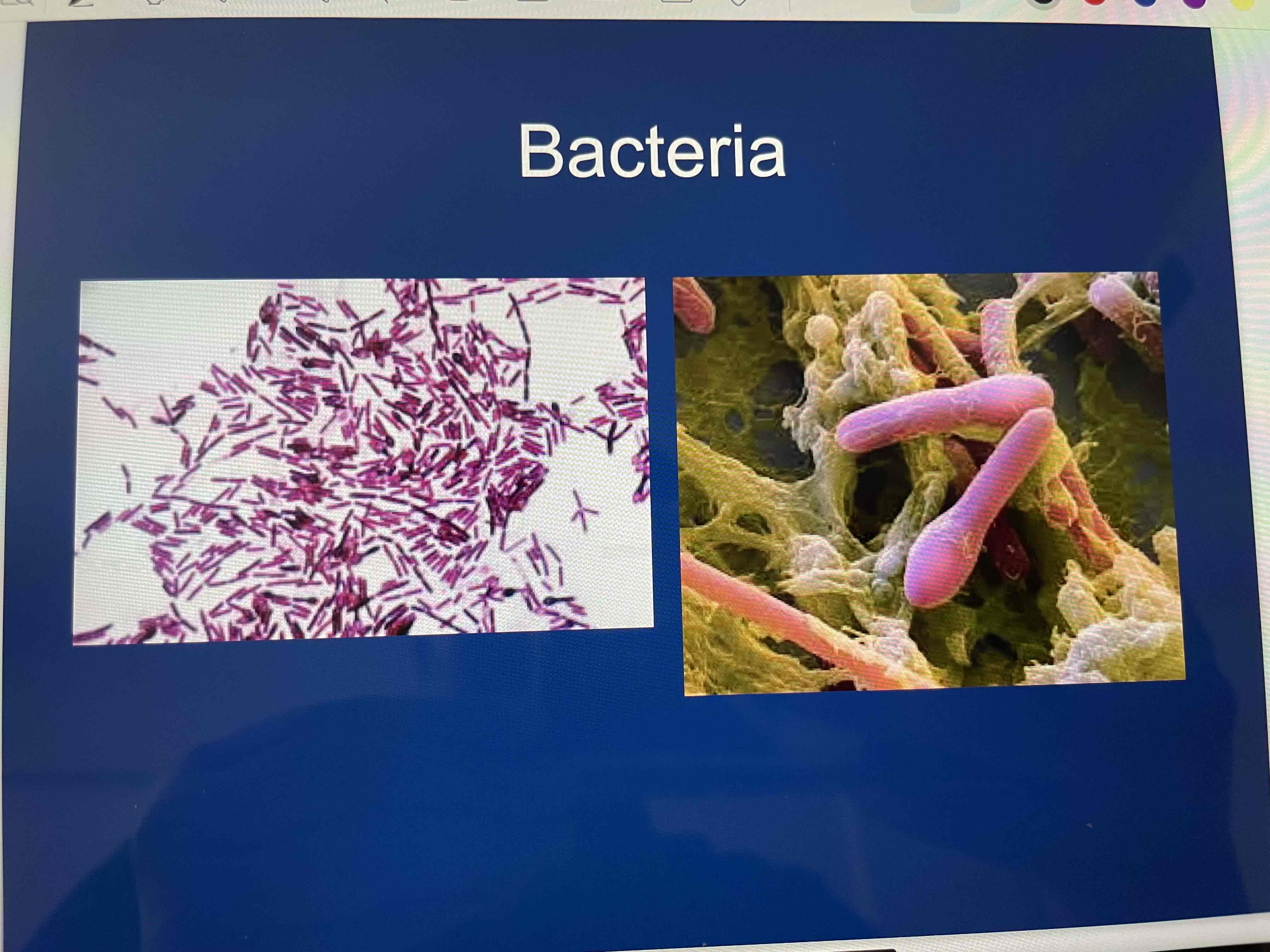
ORGANISM PROFILE: Staphylococcus aureus
*refer to Slide 15
Type: bacteria, Gram (+) cocci
Disease: skin infections with pus, boils, impetigo
Pathogenesis: (opportunistic pathogen)
Break in skin allows for infection
Production of toxins that:
Inhibit phagocytosis (cell eating; WBC eat bacteria)
Cause pus formation
Separate dermis from epidermis (exfoliative toxin) → sloughing skin
Treatment: Non-penicillin antibiotic if (MRSA), vancomycin
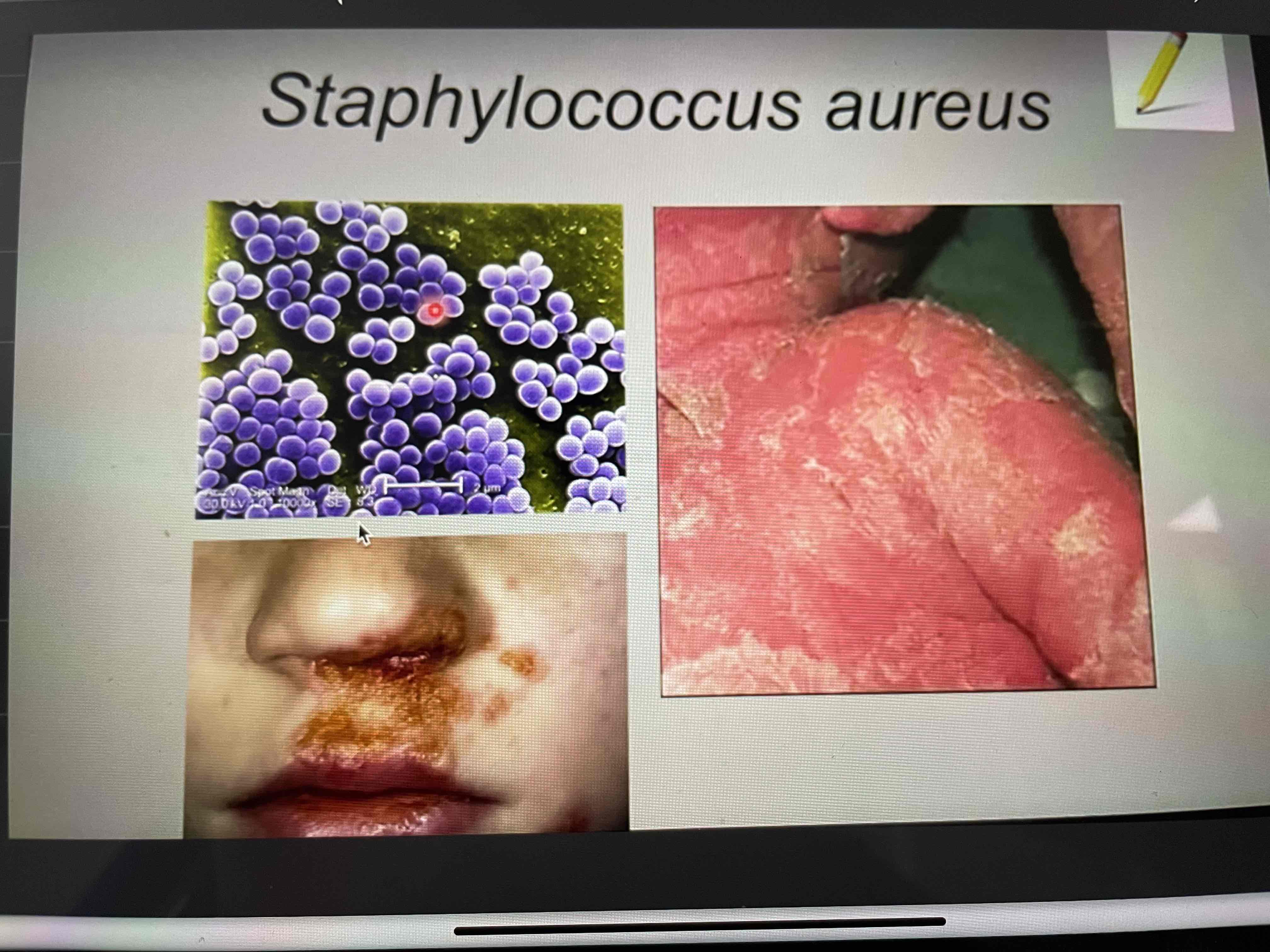
Staphylococcus aureus - Type
bacteria, Gram (+) cocci
Staphylococcus aureus - Disease
skin infections with pus, boils, impetigo
Staphylococcus aureus - Pathogenesis
(opportunistic pathogen)
Break in skin allows for infection
Production of toxins that:
Inhibit phagocytosis (cell eating; WBC eat bacteria)
Cause pus formation
Separate dermis from epidermis (exfoliative toxin) → sloughing skin
Staphylococcus aureus - Treatment
Non-penicillin antibiotic if (MRSA), vancomycin
Structure of Archaea
Unicellular
Prokaryote
Cell wall: lacks peptidoglycan
Three Main Groups of Archaea
Methanogens: methane as waste product of respiration
Extreme halophiles: live in extreme salty environments
“salt-loving”
Extreme thermophiles: live in hot environments
Reproduction of Archaea
Binary fission
Nutrition of Archaea
Heterotrophic
“organic carbon source”
Autotrophic
“using CO2 or a non-organic carbon source”
Size of Archaea
micrometers
Examples of Archaea
Halobacterium salinarum
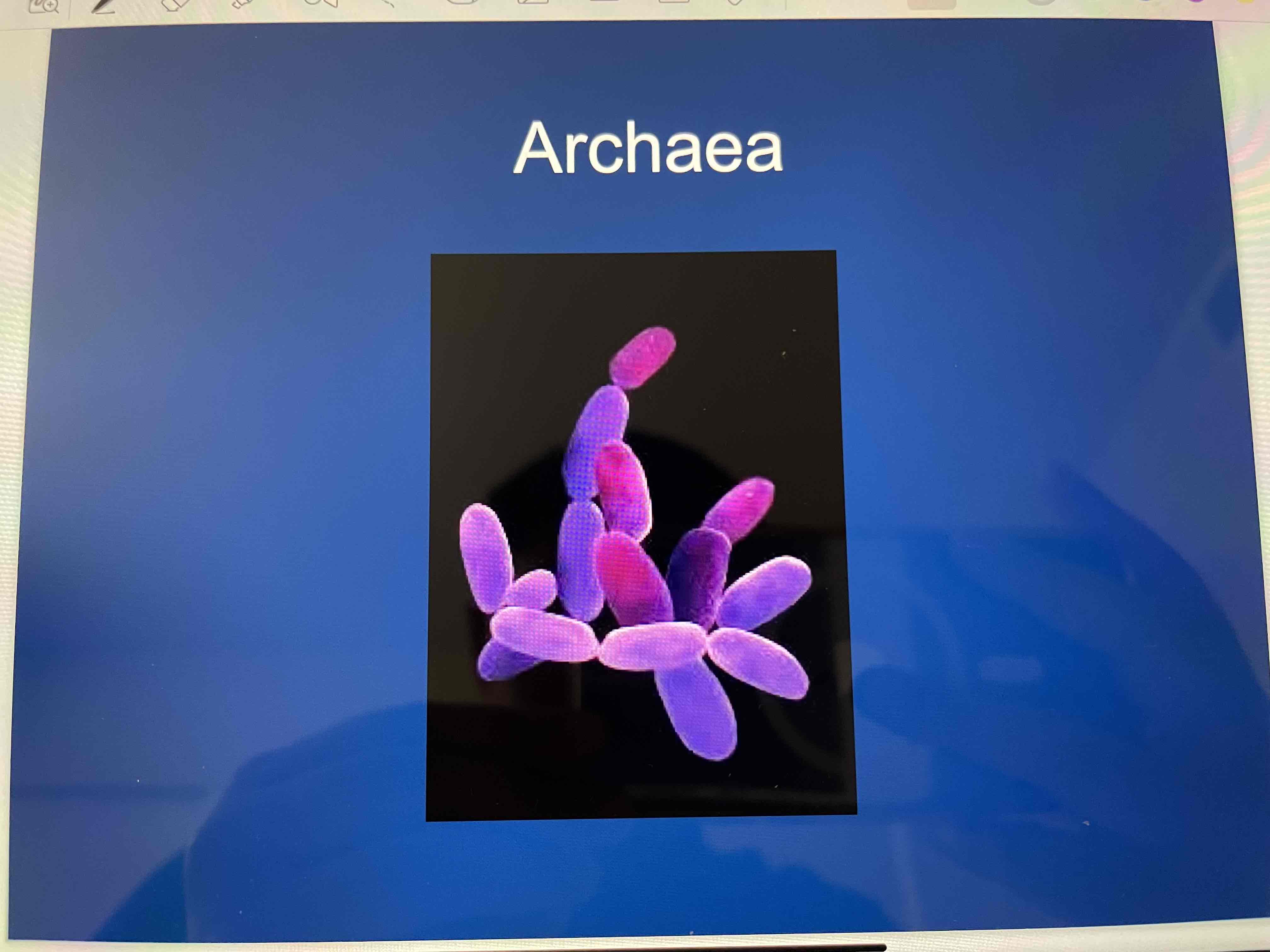
Types of Eukaryotes
Fungi
Algae
Protozoa
Helminths
Structure of Fungi
Unicellular (yeasts) or multicellular (molds)
Eukaryote: contains true nucleus and membrane-bound organelles
Cell wall: chitin
Shape:
Yeast: ovoid
“Like an oval-like shape”
Mold: filamentous hyphae
“long, thin tubes”
Reproduction of Fungi
Asexually or sexually
“depends on type of fungus”
Nutrition of Fungi
Heterotrophic
“need an organic carbon source, a lot are saprophytic”
Size of Fungi
Micrometers to millimeters
Examples of Fungi
Candida albicans
“white yeast”
Cryptococcus neoformans
“Causes lung infections”
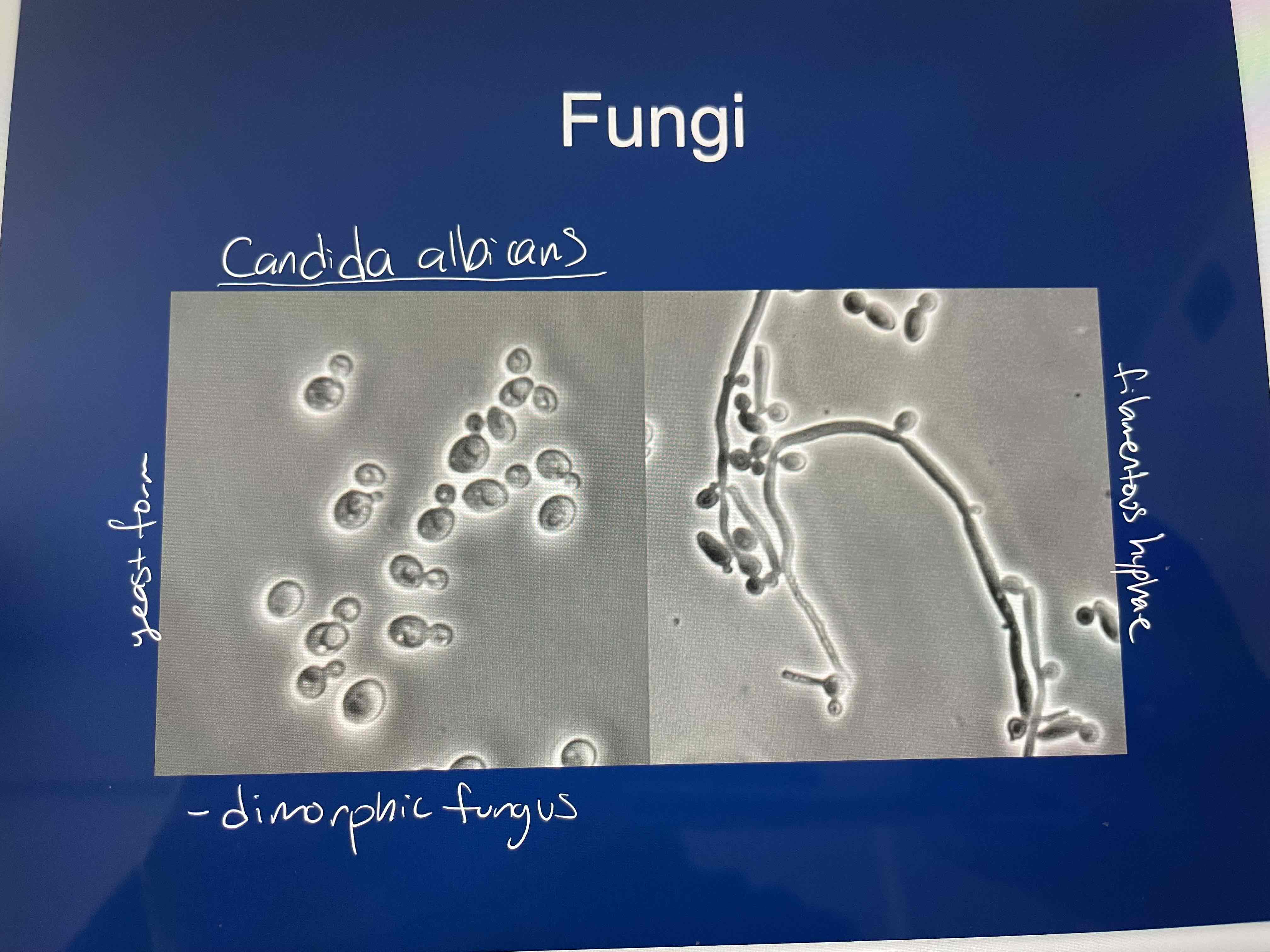
ORGANISM PROFILE: Candida albicans
*Refer to Slide 24
Type: fungi, dimorphic yeast/mold
Disease: candidiasis (yeast infection), thrush
Pathogenesis:
Opportunist, can invade when immune system is weak or bacterial normal flora is killed due to antibiotics
“if you are immuno-compromised: you may have more yeast infections or thrush more often”
Hyphal (“filamentous”) forms invades tissues
“moves faster and can get more distance”
Treatment: topical anti-fungal creams, Amphotericin B.
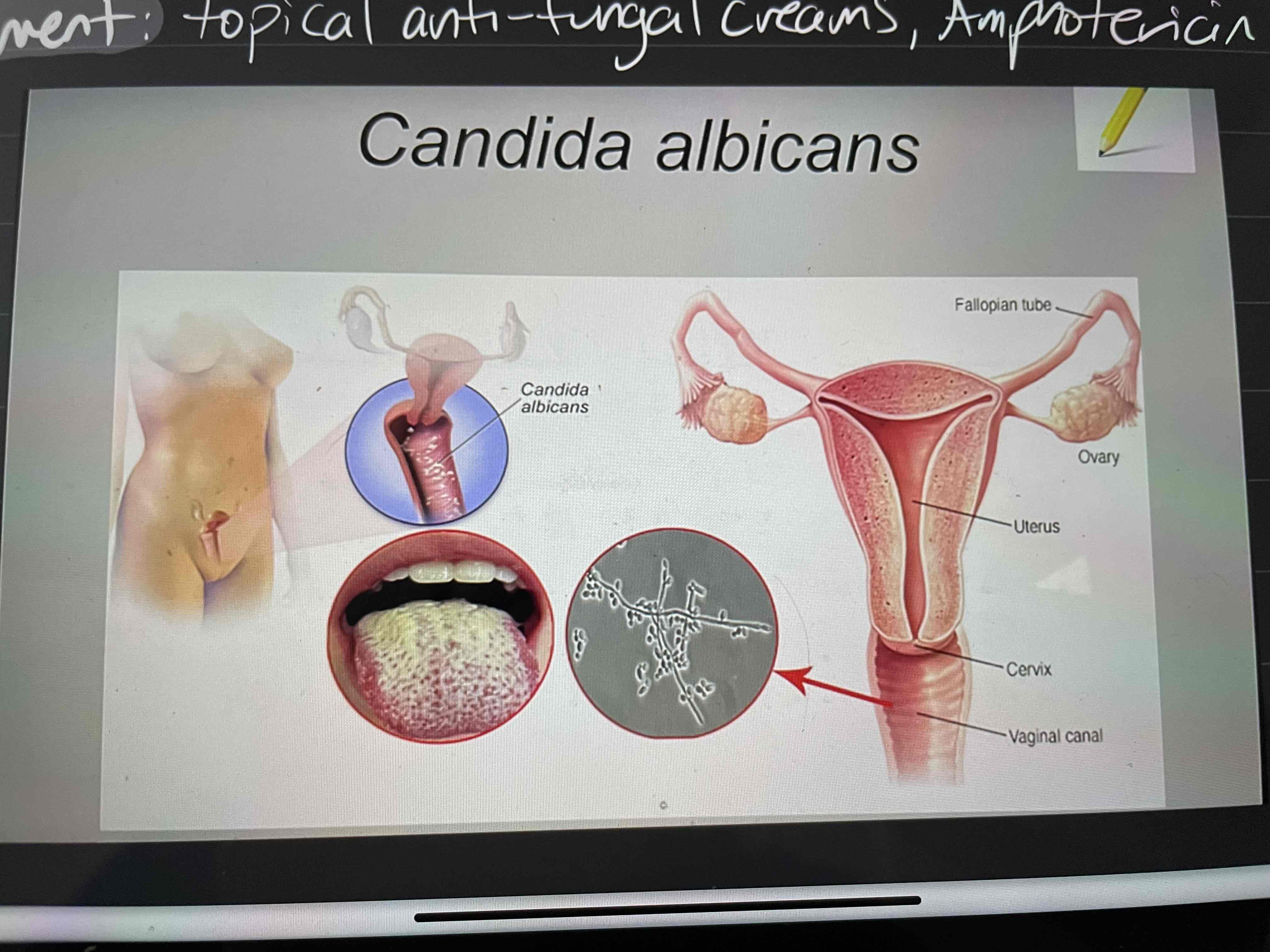
Candida albicans - Type
fungi, dimorphic yeast/mold
Candida albicans - Disease
candidiasis (yeast infection), thrush
Candida albicans - Pathogenesis
Opportunist, can invade when immune system is weak or bacterial normal flora is killed due to antibiotics
“if you are immuno-compromised: you may have more yeast infections or thrush more often”
Hyphal (“filamentous”) forms invades tissues
“moves faster and can get more distance”
Candida albicans - Treatment
topical anti-fungal creams, Amphotericin B.
Structure of Algae
Unicellular or multicellular
Eukaryote
Cell wall: cellulose
Additional structures: chloroplasts (photosynthesis)
Reproduction of Algae
Asexually or sexually
Nutrition of Algae
Autotrophic - “uses CO2 as main carbon source and makes own sugars”
Photoautotrophic: requires light, water, and carbon dioxide
“to generate sugars”
Size of Algae
Micrometers to millimeters
Examples of Algae
Volvox aureus
“golden-ish color”
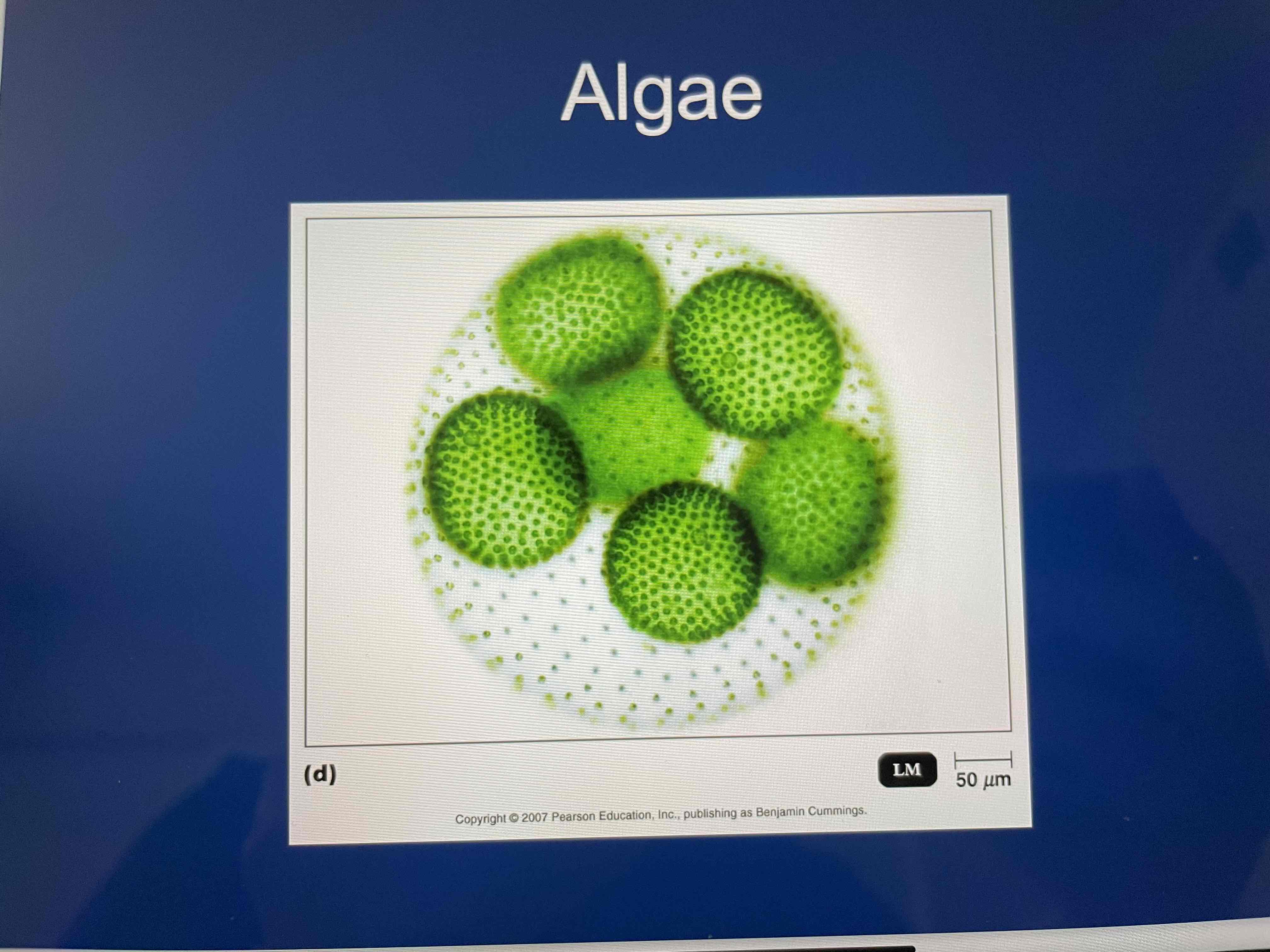
Structure of Protozoa
Unicellular
Eukaryote
Cell wall: NONE
Additional structures:
pseudopods (“fake foot, grab surface & glide over it”)
flagella
cilia (“shorter flagella”) (motility)
Reproduction of Protozoa
Asexually or sexually
Nutrition of Protozoa
Heterotrophic: “requires organic carbon source”
Size of Protozoa
micrometers
Examples of Protozoa
Giardia lamblia
Plasmodium falciparum
“causes malaria”
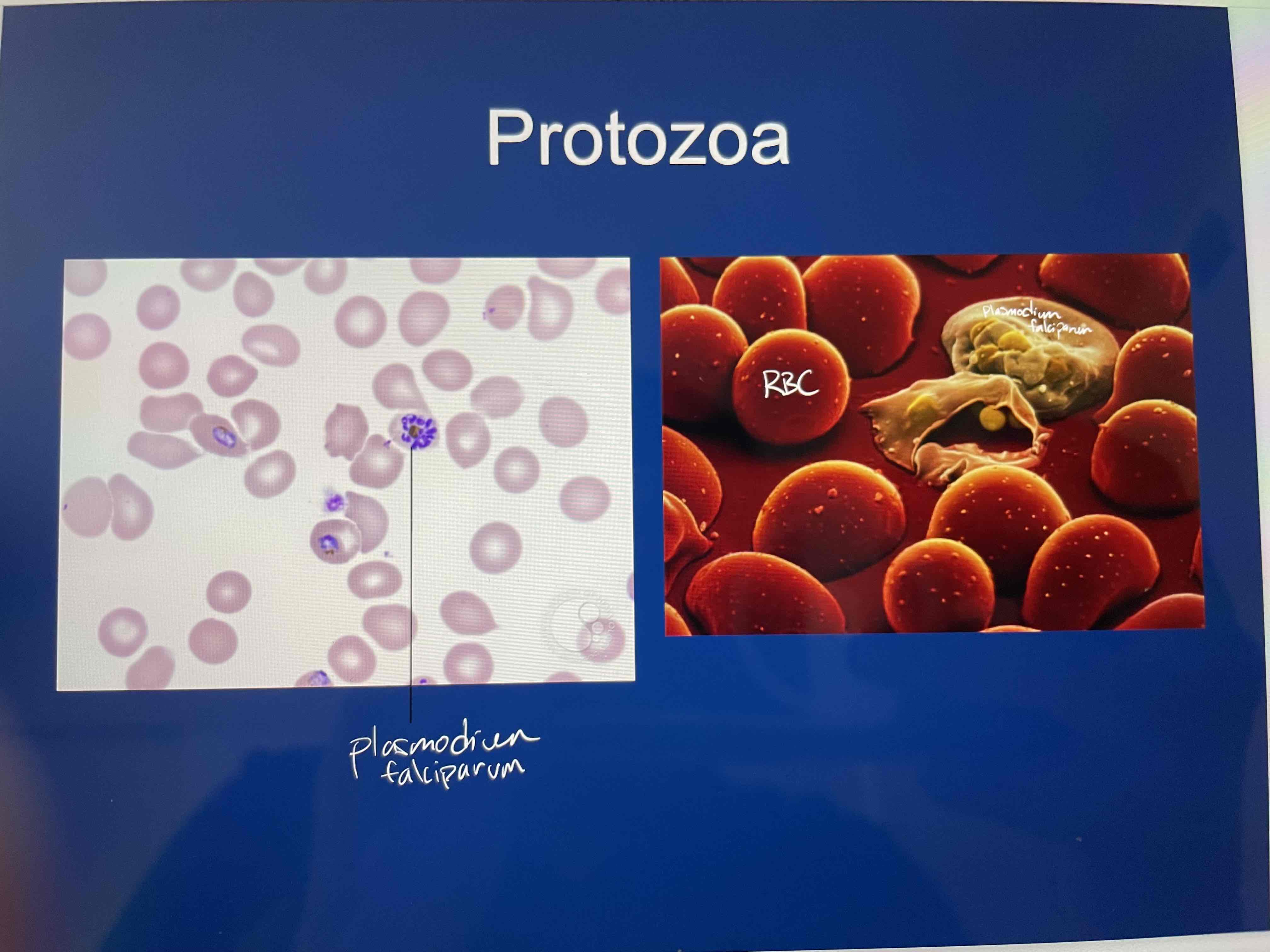
ORGANISM PROFILE: Giardia lamblia
*Refer to Slide 31
Type: protozoa
Disease: giardiasis - diarrhea, inability to absorb fatty foods
Pathogenesis:
Cyst ingested and becomes trophozoite in small intestines
Trophozoites attach to epithelial tissue → inflammation
Interferes with absorption of (fatty) food and fluids
Treatment: metronidazole (anti-protozoan drug)
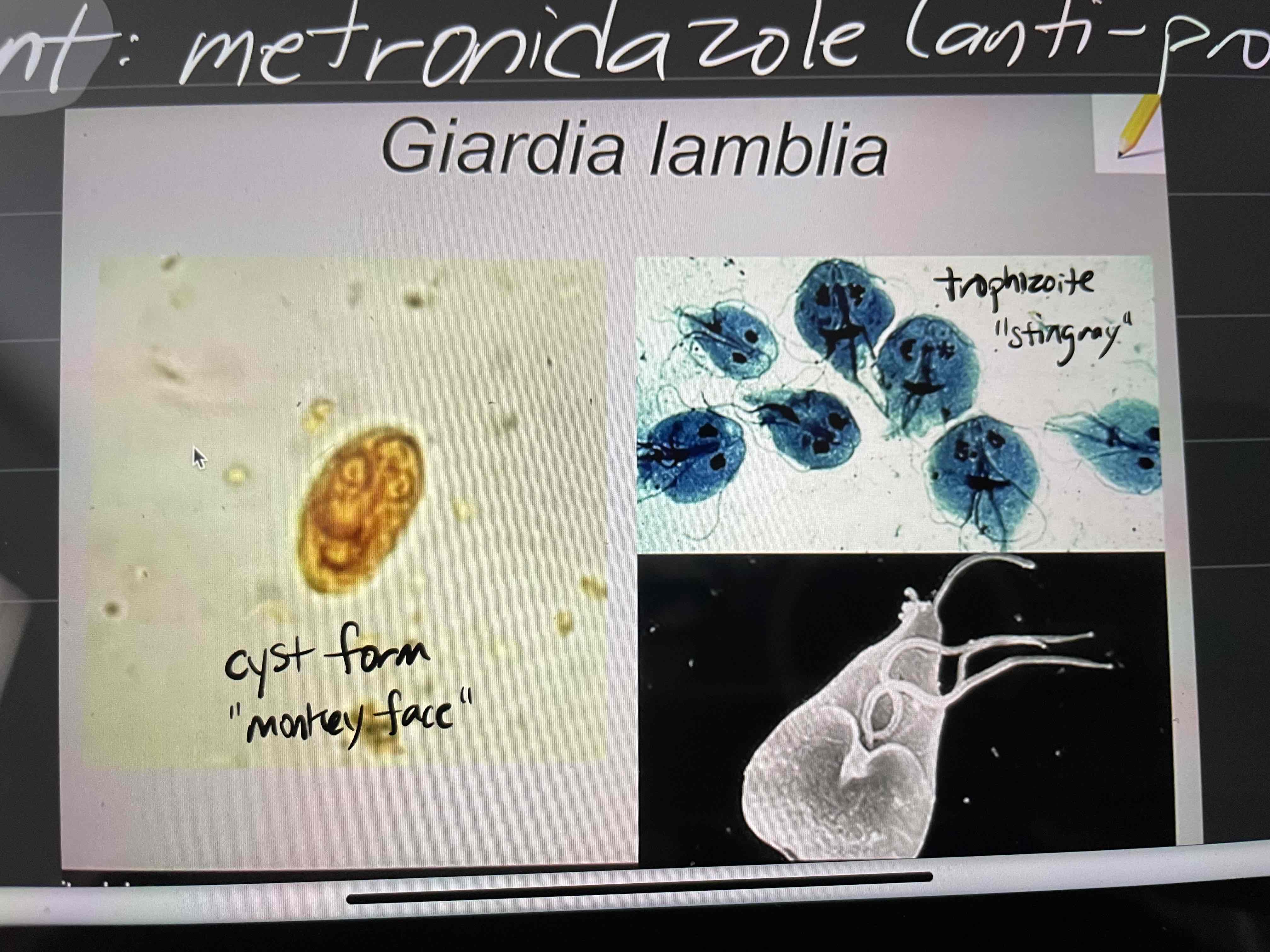
Giardia lamblia - Type
protozoa
Giardia lamblia - Disease
giardiasis - diarrhea, inability to absorb fatty foods
Giardia lamblia - Pathogenesis
Cyst ingested and becomes trophozoite in small intestines
Trophozoites attach to epithelial tissue → inflammation
Interferes with absorption of (fatty) food and fluids
Giardia lamblia - Treatment
metronidazole (anti-protozoan drug)
Structure of Helminths
Multicellular (round and flat worms)
Eukaryote
Cell wall: NONE
“type of animal”
Reproduction of Helminths
Asexual or sexual
dioecious
“male/female form”
hermaphroditic
“organism has both male and female parts”
Nutrition of Helminths
Heterotrophic
“requires organic carbon source”
Size of Helminths
MACROSCOPIC
Microscopic at certain stages of life cycle
Examples of Helminths
Taenia solium
“pork tape worm”
Enterobius vermicularis
“pinworm”
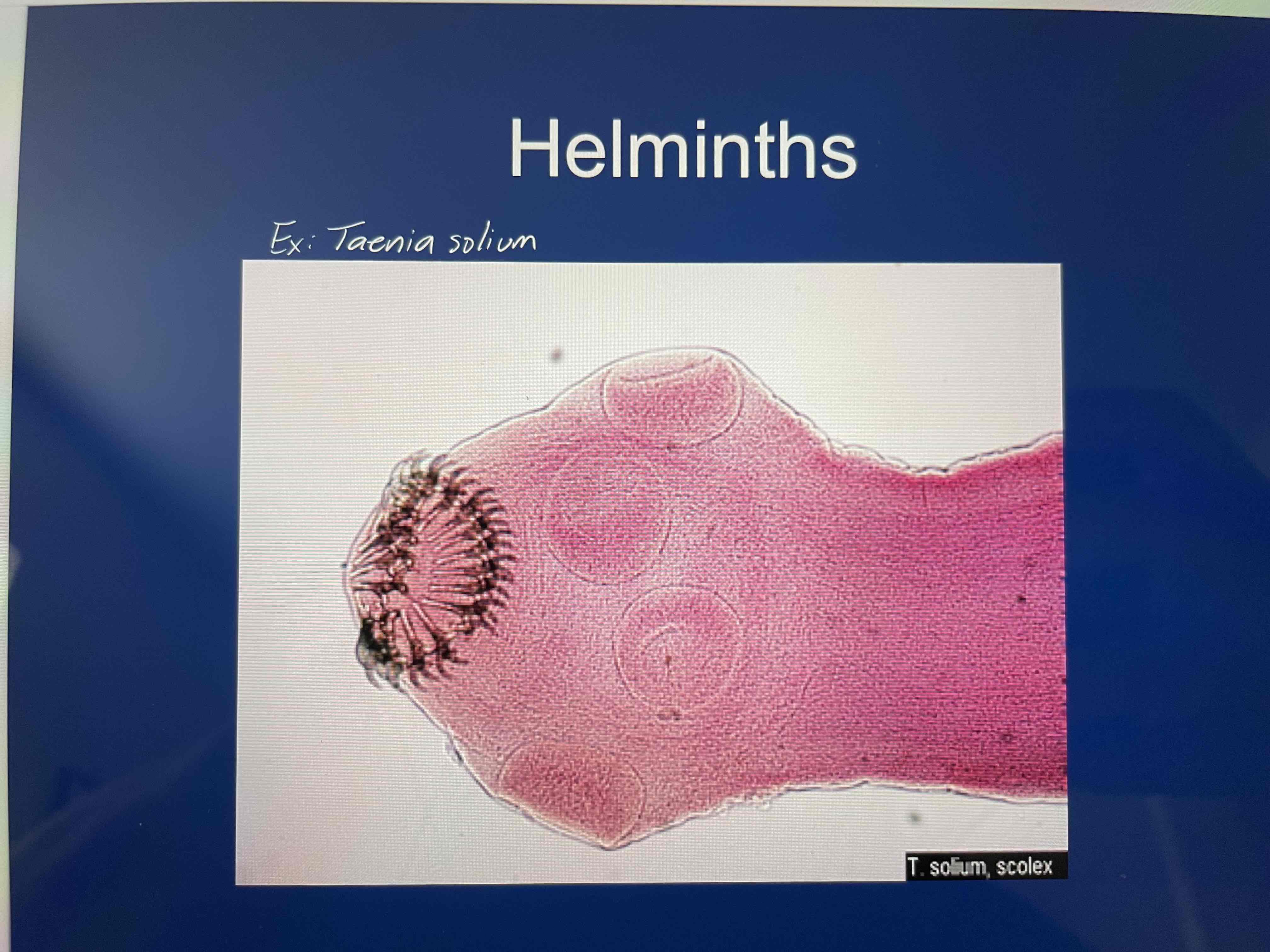
ORGANISM PROFILE: Enterobius vermicularis
*Refer to Slide 35
Type: helminth, pinworm
Disease: enterobiasis - intestinal infection, nocturnal anal itch
Pathogenesis:
Eggs ingested and hatch in duodenum
Females emerge at night and lay eggs around anus → itching
Treatment: mebendazole (oral anti-helminth drug)
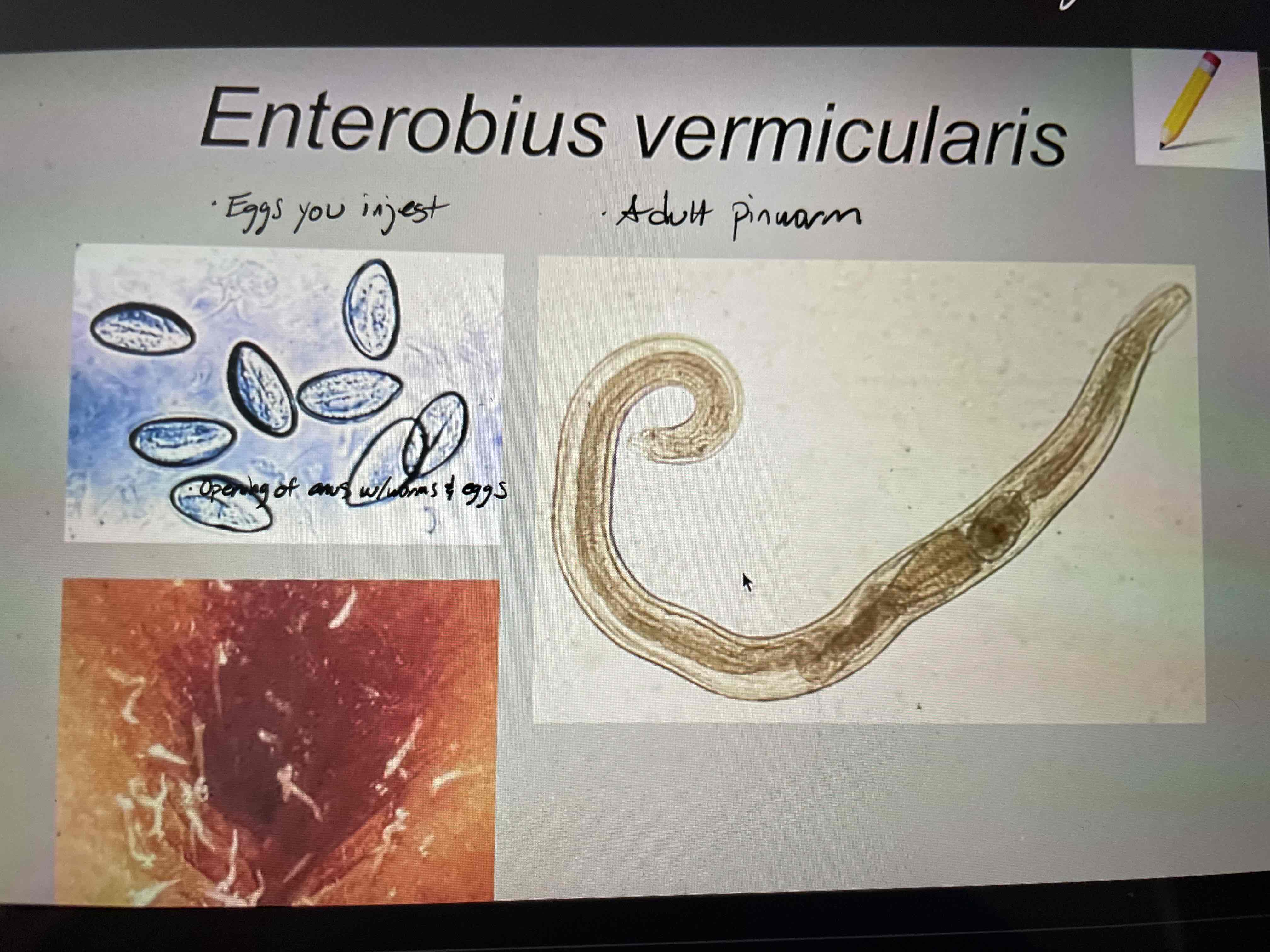
Enterobius vermicularis - Type
helminth, pinworm
Enterobius vermicularis - Disease
enterobiasis - intestinal infection, nocturnal anal itch
Enterobius vermicularis - Pathogenesis
Eggs ingested and hatch in duodenum
Females emerge at night and lay eggs around anus → itching
Enterobius vermicularis - Treatment
mebendazole (oral anti-helminth drug)
Types of Acellular Forms
Viruses
Viroids
“like a virus”
Prions
Structure of Viruses
Acellular
“no cell, can’t reproduce on its own”
Nucleic acid core (DNA or RNA)
Capsid: protein coat
“protection”
Envelope: outer membrane (some)
Reproduction of Viruses
Obligate intracellular parasites
“has to be in a cell in order to reproduce; will do damage”
Size of Viruses
nanometers
“1000x smaller than micrometer”
Examples of Viruses
HIV
Herpes Simplex Virus (HSV)
Influenza B
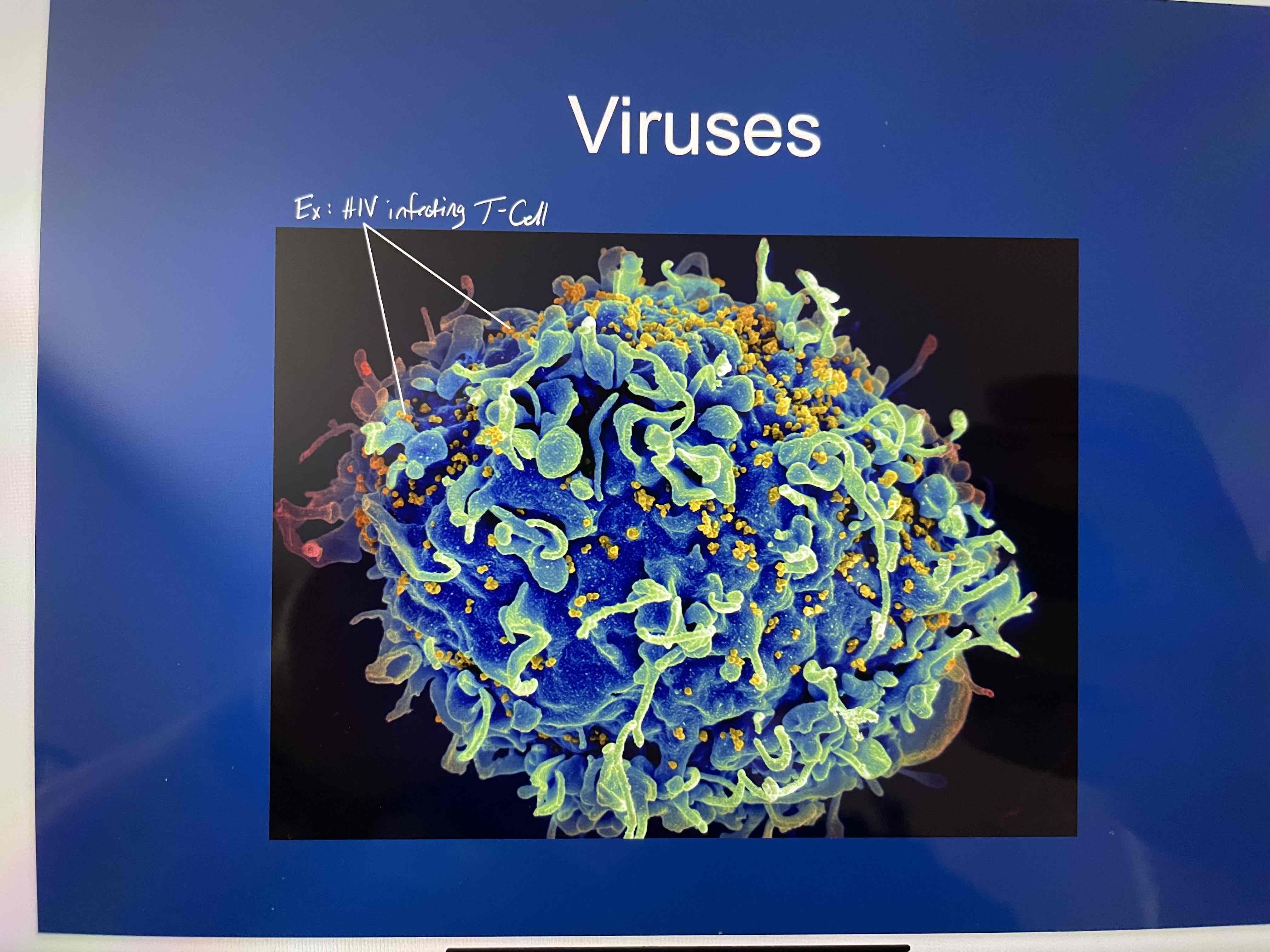
ORGANISM PROFILE: Herpes Simplex Virus I (HSV I)
*Refer to Slide 40
Type: DNA Virus, enveloped
Disease: cold sores - ulcerative lesions on gum and lips (herpes)
Pathogenesis:
Virus enters through oral contact w/infected host
Replicates in epithelial cells → vesicles
Virus ascends sensory neuron to posterior root ganglion
Remains dormant until future outbreak
Treatment: Acyclovir (anti-viral) before vesicles form

Herpes Simplex Virus I (HSV I) - Type
DNA Virus, enveloped
Herpes Simplex Virus I (HSV I) - Disease
cold sores - ulcerative lesions on gum and lips (herpes)
Herpes Simplex Virus I (HSV I) - Pathogenesis
Virus enters through oral contact w/infected host
Replicates in epithelial cells → vesicles
Virus ascends sensory neuron to posterior root ganglion
Remains dormant until future outbreak
Herpes Simplex Virus I (HSV I) - Treatment
Acyclovir (anti-viral) before vesicles form
Structure of Viroids
“virus-like structure”
Acellular
Linear or circular RNA
NO CAPSID
Size of Viroids
10x smaller than the smallest virus
Examples of Viroids
Potato Spindle Tuber Viroid (PSTVd)
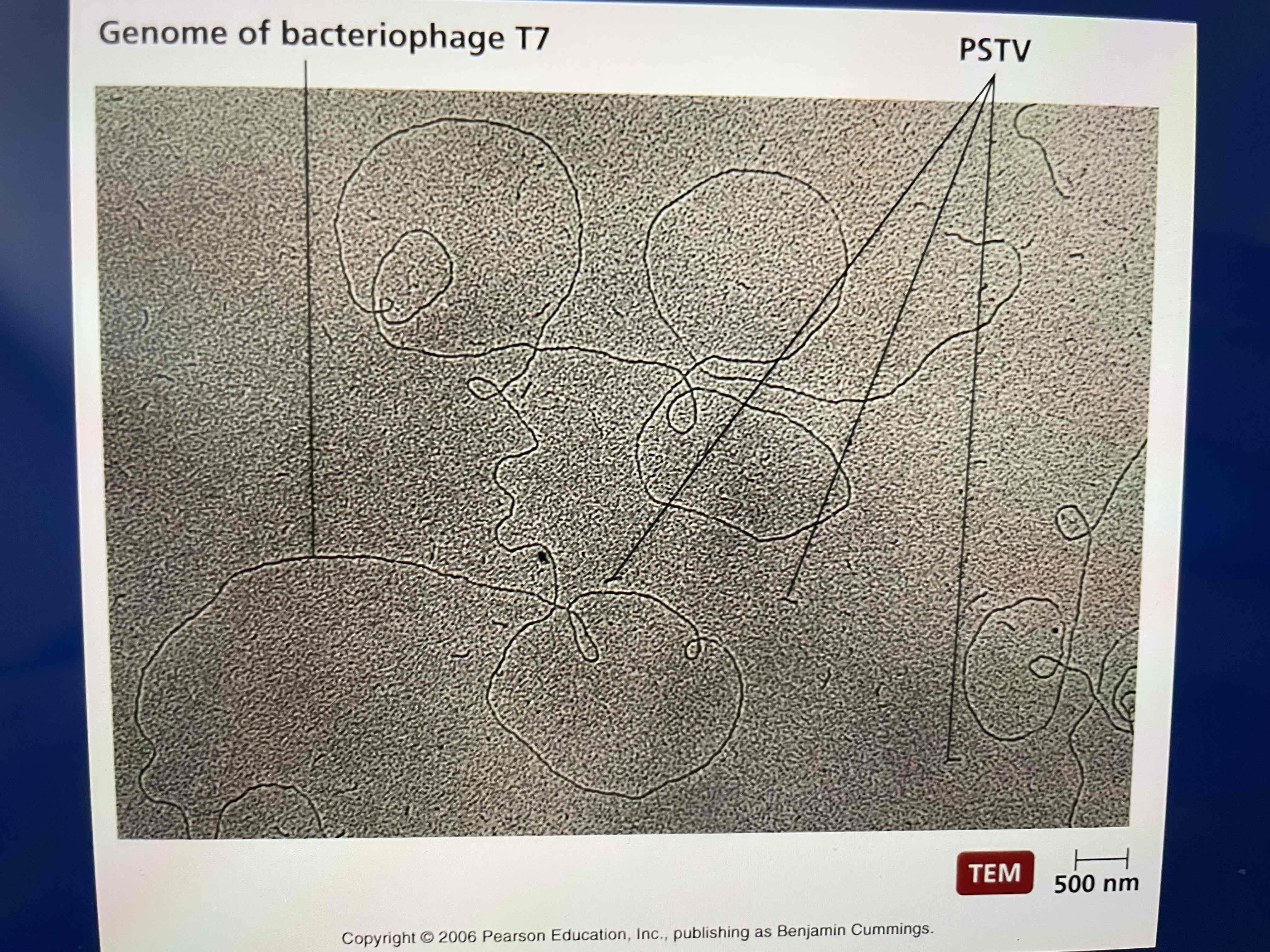
Structure of Prions
Acellular
Self-replicating infectious protein
“hard to destroy”
Size of Prions
100x smaller than the smallest virus
Examples of Prions
Creutzfeldt Jakobs Disease (CJD)
Mad cow disease
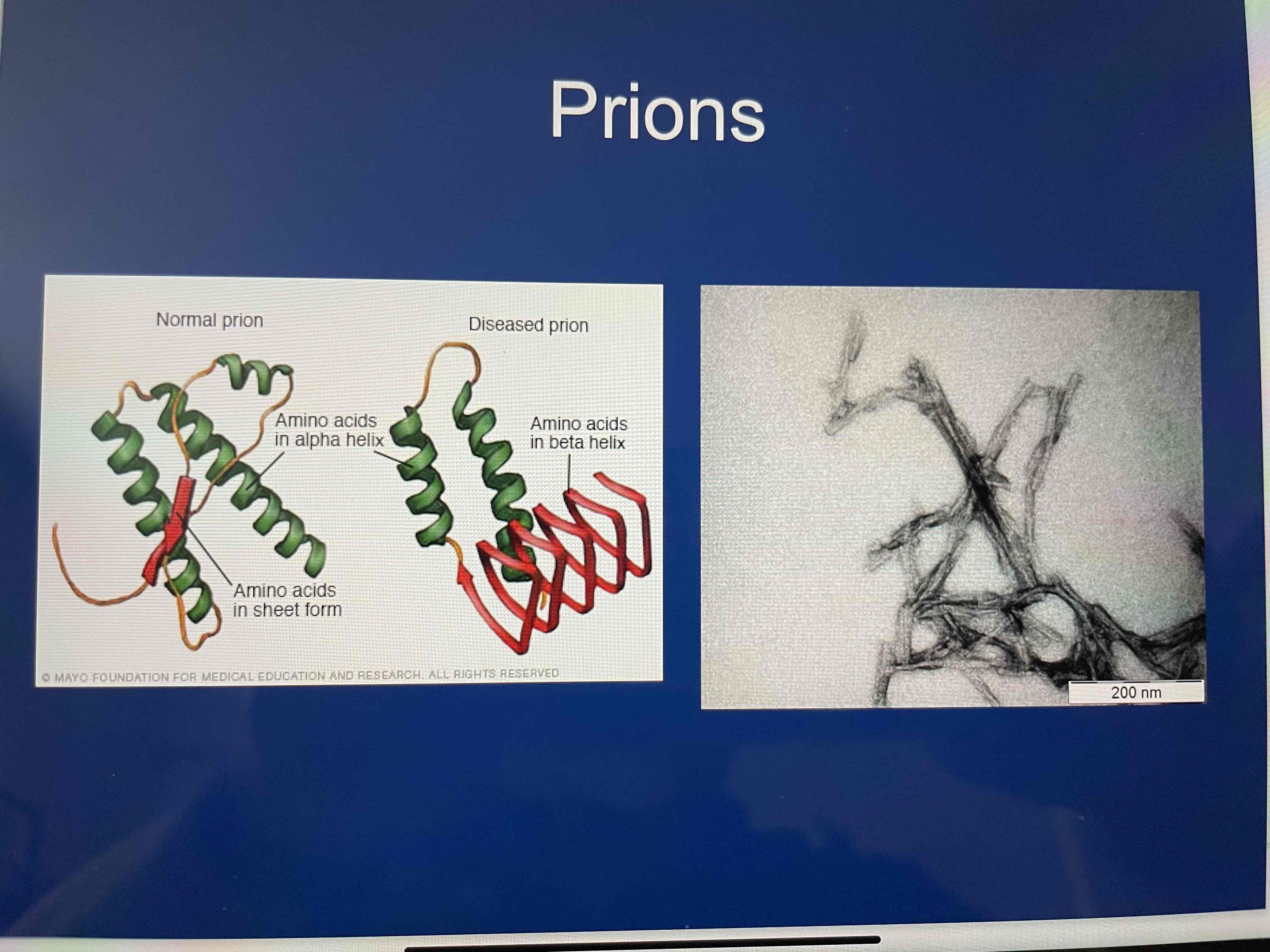
ORGANISM PROFILE: PrPSc prion
*Refer to Slide 45
Type: prion
Disease: Creutzfeldt - Jakob’s Disease (CJD)
Degeneration of CNS → dementia, abnormal motor function → death
Pathogenesis:
PrPSc (misfolded protein) converts a PrPC (normal protein) →PrPSc
PrPSc aggregate to form deposits in brain → vacuoles (gaps/circles in brain; swiss cheese)
Treatment: NONE
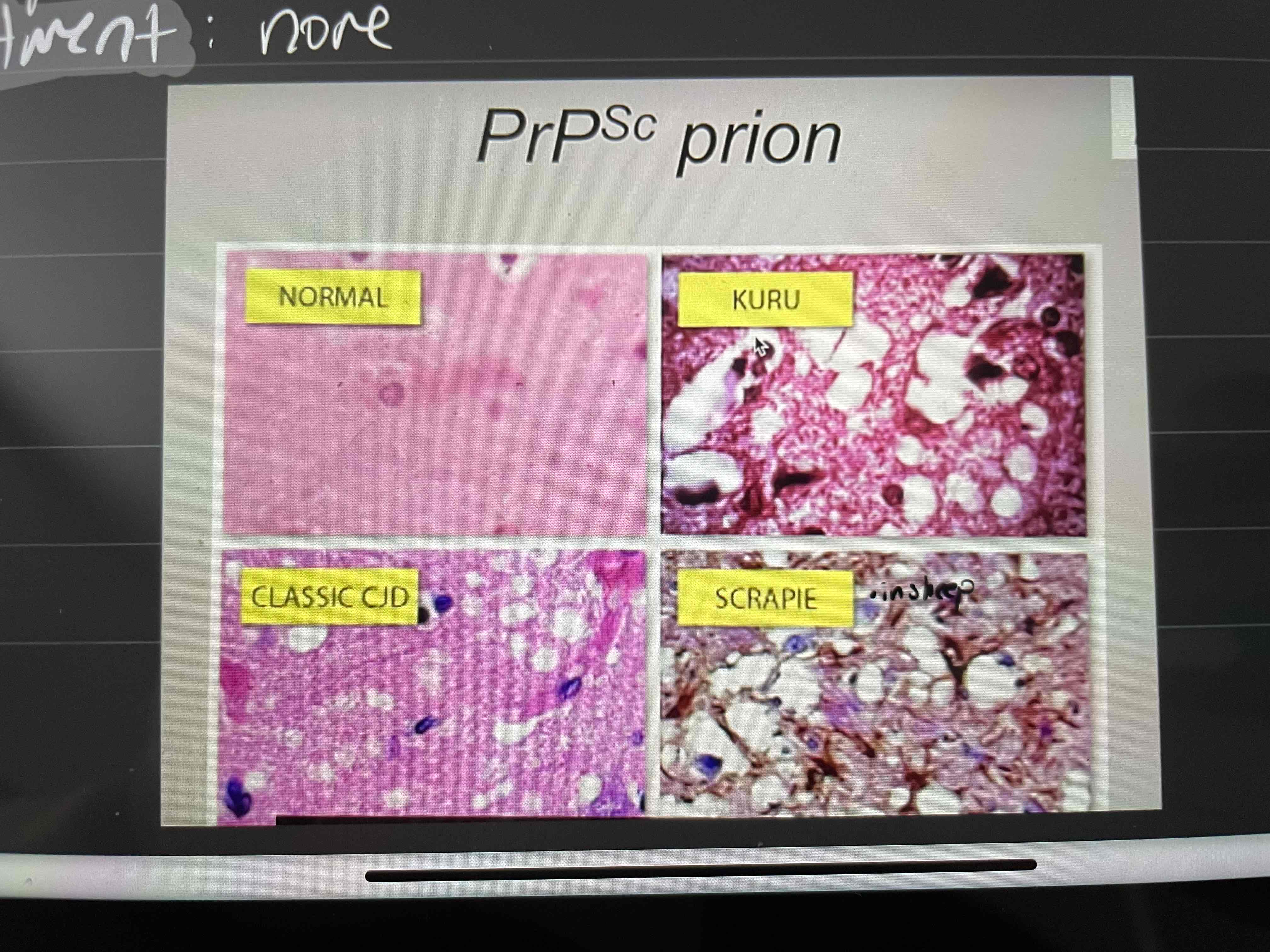
PrPSc prion - Type
prion
PrPSc prion - Disease
Creutzfeldt - Jakob’s Disease (CJD)
Degeneration of CNS → dementia, abnormal motor function → death
PrPSc prion - Pathogenesis
PrPSc (misfolded protein) converts a PrPC (normal protein) →PrPSc
PrPSc aggregate to form deposits in brain → vacuoles (gaps/circles in brain; swiss cheese)
PrPSc prion - Treatment
NONE
Classification Schemes: Taxonomy
System for naming, organizing, and classifying living things
How does Taxonomy work?
Identify organism
Classify organism
Type of cell structure
“cell wall, size, pro or eukaryote, etc.”
Type of nutrition
“autotrophic, heterotrophic, etc.”
Similarity in nucleic acids
Name organism
“Binomial Latin nomenclature”
Who came up with the Three Domain System of Classification?
Carl Woese in 1978!
Three Domain System of Classification
Domain Bacteria
Domain Archaea
Domain Eukarya
“Does not account for acellular forms (viruses, viroids, prions); kept separate
Domain Bacteria
Prokaryotes with cell walls containing peptidoglycan
Domain Archaea
Prokaryotes with cell walls lacking peptidoglycan
Domain Eukarya
Protists: slime molds, protozoa, algae
Fungi: yeasts, molds, mushrooms
Plants: mosses, ferns, conifers, flowering plants
Animals: sponges, worms, insects, vertebrates
When naming an organism:
A) the genus is lowercased
B) the scientific epithet is capitalized
C) only the genus should be underlined
D) none of the above
You discover a unicellular prokaryote near underwater volcanic vents. The organism has a cell wall lacking peptidoglycan. Your organism is most likely a(n):
A) bacteria
B) helminth
C) archaea
D) protozoa
Which of the following organisms is most likely the cause of nocturnal anal itching?
A) Staphylococcus aureus
B) Enterobius vermicularis
C) Giardia lamblia
D) PrPSc
Prions:
A) are made of only RNA
B) cause thrush
C) are prokaryotes
D) are self-replicating proteins
Which domain does Giardia lamblia belong?
A) Domain Eukarya
B) Domain Fungi
“does not exist”
C) Domain Bacteria
D) Domain Archaea